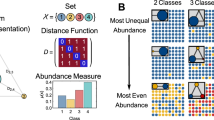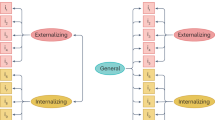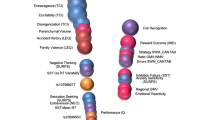Abstract
There is increasing appreciation that certain biological processes may not be equally related to all psychiatric symptoms in a given diagnostic category. Research on the biological phenotyping of psychopathology has begun examining the etiological and treatment implications of identified biotypes; however, little attention has been paid to a critical methodological implication of these results: measurement noninvariance. Measurement invariance is the ability of an instrument to measure the same construct, the same way, across different people, or across different time points for the same individual. If what a measure quantifies differs across different people (e.g., those with or without a particular biotype) or time points, then it is invalid to directly compare means on that measure. Using a running example of inflammatory phenotypes of depression, we first describe the biological phenotyping of psychopathology. Second, we discuss three types of measurement invariance. Third, we demonstrate how differential biology-symptom associations invariably creates measurement noninvariance using a theoretical example and simulated data (for which code is provided). We also show how this issue can lead to false conclusions about the broader diagnostic construct. Finally, we provide several suggestions for addressing these important issues to help advance the field of biological psychiatry.
This is a preview of subscription content, access via your institution
Access options
Subscribe to this journal
Receive 12 print issues and online access
$259.00 per year
only $21.58 per issue
Buy this article
- Purchase on Springer Link
- Instant access to full article PDF
Prices may be subject to local taxes which are calculated during checkout


Similar content being viewed by others
References
Majd M, Saunders EFH, Engeland CG. Inflammation and the dimensions of depression: a review. Front Neuroendocrinol. 2020;56.
Fried EI, Nesse RM, Zivin K, Guille C, Sen S. Depression is more than the sum score of its parts: individual DSM symptoms have different risk factors. Psychol Med. 2014;44:2067–76.
Slavich GM, Irwin MR. From stress to inflammation and major depressive disorder: a social signal transduction theory of depression. Psychol Bull. 2014;140:774–815.
Moriarity DP. Building a replicable and clinically-impactful immunopsychiatry: methods, phenotyping, and theory integration. Brain Behav Immun-Heal. 2021;16.
Mac Giollabhui N, Ng TH, Ellman LM, Alloy LB. The longitudinal associations of inflammatory biomarkers and depression revisited: systematic review, meta-analysis, and meta-regression. Mol Psychiatry. 2020:1–13.
Fried EI, von Stockert S, Haslbeck JMB, Lamers F, Schoevers RA, Penninx BWJH. Using network analysis to examine links between individual depressive symptoms, inflammatory markers, and covariates. Psychol Med. 2019. 2019. https://doi.org/10.31234/osf.io/84ske.
Moriarity DP, Horn SR, Kautz MM, Haslbeck JM, Alloy LB. How handling extreme C-reactive protein (CRP) values and regularization influences CRP and depression criteria associations in network analyses. Brain Behav Immun. 2021;91:393–403.
Milaneschi Y, Kappelmann N, Ye Z, Lamers F, Moser S, Jones PB, et al. Association of inflammation with depression and anxiety: evidence for symptom-specificity and potential causality from UK Biobank and NESDA Cohorts. Mol Psychiatry. https://doi.org/10.1101/2021.01.08.20248710.
Moriarity DP, Alloy LB. Beyond diagnoses and total symptom scores: diversifying the level of analysis in psychoneuroimmunology research. Brain Behav Immun. 2020;89:1–2.
Putnick DL, Bornstein MH. Measurement invariance conventions and reporting: the state of the art and future directions for psychological research. Dev Rev. 2016;41:71–90.
McNeish D, Wolf MG. Thinking twice about sum scores. Behav Res Methods. 2020;52:2287–305.
Kroenke K, Spitzer RL, Williams JB. The PHQ‐9: validity of a brief depression severity measure. J Gen Intern Med. 2001;16:606–13.
Bauer D. A more general model for testing measurement invariance and differential item functioning. Psychol Methods. 2017;22:507–26.
Dooley LN, Kuhlman KR, Robles TF, Eisenberger NI, Craske MG, Bower JE. The role of inflammation in core features of depression: insights from paradigms using exogenously-induced inflammation. Neurosci Biobehav Rev. 2018;94:219–37.
Isvoranu AM, Guloksuz S, Epskamp S, van Os J, Borsboom D. Toward incorporating genetic risk scores into symptom networks of psychosis. Psychol Med. 2020;50:636–43.
van Loo HM, Van Borkulo CD, Peterson RE, Fried EI, Aggen SH, Borsboom D, et al. Robust symptom networks in recurrent major depression across different levels of genetic and environmental risk. J Affect Disord. 2018;227:313–22.
Santos H, Fried EI, Asafu-Adjei J, Jeanne, Ruiz R. Network structure of perinatal depressive symptoms in Latinas: relationship to stress and reproductive biomarkers. Res Nurs Heal. 2017;40:218–28.
Okada K, Nakao T, Sanematsu H, Murayama K, Honda S, Tomita M, et al. Biological heterogeneity of obsessive-compulsive disorder: a voxel-based morphometric study based on dimensional assessment. Psychiatry Clin Neurosci. 2015;69:411–21.
Hilland E, Landrø NI, Kraft B, Tamnes CK, Fried EI, Maglanoc LA, et al. Exploring the links between specific depression symptoms and brain structure: a network study. Psychiatry Clin Neurosci. 2020;74:220–1.
Kotov R, Krueger RF, Watson D, Bagby M, Carpenter WT, Caspi A. The hierarchical taxonomy Of Psychopathology (HiTOP). J Abnorm Psychol. 2017:1–83.
Feczko E, Miranda-dominguez O, Marr M, Graham AM, Nigg JT, Fair DA. The heterogeneity problem: approaches to identify psychiatric subtypes. Trends Cogn Sci. 2019:1–18.
Insel T, Cuthbert B, Garvey M, Heinssen R, Pine D, Quinn K, et al. Research Domain Criteria (RDoC): toward a new classification framework for research on mental disorders. Am J Psychiatry Online. 2010;167:748–51.
Ryff CD, Seeman T, Weinstein M. Midlife in the United States (MIDUS 2): Biomarker Project, 2004-2009. Ann Arbor, MI Inter-University Consort Polit Soc Res. [Distributor]. 2017:10.
Allen NE, Sudlow C, Peakman T, Collins RUK. Biobank data: come and get it. Sci Transl Med. 2014;6:4–7.
Volkow ND, Koob GF, Croyle RT, Bianchi DW, Gordon JA, Koroshetz WJ, et al. The conception of the ABCD study: from substance use to a broad NIH collaboration. Dev Cogn Neurosci. 2018;32:4–7.
Acknowledgements
DPM was supported by National Research Service Award F31 MH122116 and an APF Visionary Grant. KJJ was supported by a Ford Foundation Predoctoral Fellowship administered by the National Academy of Sciences, Engineering, and Medicine and National Institute of Drug Abuse R36 DA050049. GMS was supported by National Institutes of Health grant K08 MH103443 and by grant OPR21101 from the California Initiative to Advance Precision Medicine. LBA was supported by National Institute of Mental Health R01 MH101168.
Author information
Authors and Affiliations
Contributions
DPM generated the idea for the manuscript, wrote the manuscript, and ran analyses. KJJ helped refine theoretical underpinning of the manuscript, consulted on code, and provided feedback on the manuscript. GMS and LBA provided feedback on the manuscript.
Corresponding author
Ethics declarations
Competing interests
The authors declare no competing interests.
Additional information
Publisher’s note Springer Nature remains neutral with regard to jurisdictional claims in published maps and institutional affiliations.
Supplementary information
Rights and permissions
About this article
Cite this article
Moriarity, D.P., Joyner, K.J., Slavich, G.M. et al. Unconsidered issues of measurement noninvariance in biological psychiatry: A focus on biological phenotypes of psychopathology. Mol Psychiatry 27, 1281–1285 (2022). https://doi.org/10.1038/s41380-021-01414-5
Received:
Revised:
Accepted:
Published:
Issue Date:
DOI: https://doi.org/10.1038/s41380-021-01414-5
This article is cited by
-
Psychopathological network for early-onset post-stroke depression symptoms
BMC Psychiatry (2023)
-
Structural disconnection-based prediction of poststroke depression
Translational Psychiatry (2022)



